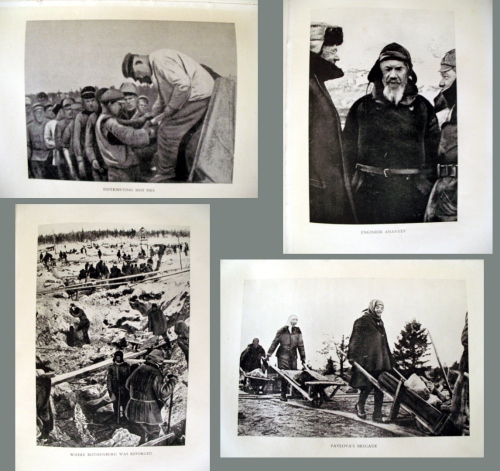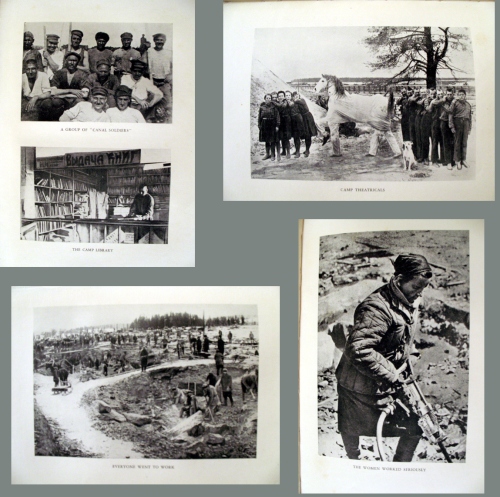Built between 1931 and 1933, the White Sea Canal was the prototypical construction project using forced labour pioneered by the Stalinist regime. It has been estimated that over 100,000 prisoners died during the construction of a ship canal designed to allow ships a more direct access to the Baltic Sea rather than having to go around Scandinavia. The construction of the canal was carried out by the OGPU secret police (precursors to the KGB) who brutally supervised the unfortunates who were sacrificed in vain to build a canal that ultimately proved to be useless (it was too shallow for the large cargo ships it was supposed to transport.)
This book was published in 1935 by Bodley Head in England (there is also a US edition called Belomor) and written by a committee of writers led by Maxim Gorky who do a masterful job of twisting what was in reality a horrendously brutal and viscous regime where thousands of people were mercilessly worked to death in order to construct a narrative that is breathtaking in its cynicism. Within the pages of the book we meet a number of inmates who are presented as either criminals or political opponents who opposed Stalin’s murderous rule. By labouring on the canal they all finally come to understand the error of their former ways and find salvation and redemption through participating in this collective endeavour. Within this grotesquely surreal narrative the Gulag guards are transformed from sadistic, brutalised butchers of Stalinist terror into benevolent, even paternalistic father-confessor figures, whose only goal is to ‘reforge’ the unfortunate inmates so that they can become happy workers. At the end of the book there’s even a happy ending as the arch-psychopath himself, Stalin, pays a visit and sees what a great job everybody has done in building this pointless canal. This is Orwell’s world come to life.
Accompanying the 340 page text are 25 photographs which range from portraits of influential individuals (camp commandants, Yagoda head of the OGPU, Stalin etc.) to depictions of the construction and images of individuals plucked from the mass of inmates who are held up as successful examples of those who found redemption through labour.
Like the text, individual photographers are uncredited and many of the images are straightforward record photographs (some very heavily retouched) but there are 2 made by Rodchenko that stand out. Rodchenko’s experimental avant-garde style which had been tolerated in the decade after the Russian revolution was coming under increasing criticism as Stalin ascended to power. Socialist-Realism was the only game in town by the 1930s and those who tried to do anything different risked joining the ever increasing numbers that disappeared into Gulag. In an effort to curry favour, Rodchenko visited the canal site and produced photographs which appeared in the infamous issue of USSR in Construction (two of which, Shock-Workers and Music Speeds the Men on the Sluice appear in the book.)
The 1930’s were the high point of the documentary book and this is a Stalinist attempt to legitimate murder and slave labour in the eyes of a foreign audience. Although this is not really a photo-book, for a horrifying example of how totalitarian regimes cynically twist reality, obliterate history and destroy the individual, look no further.
Interstingly, the Russian language version of this book was banned a few years later in 1937 when Yagoda, the head of the OGPU photographed here, was himself imprisoned and brutally executed on Stalin’s orders. Ironically, possession of this book, with the disgraced Yagoda’s picture in it, was a crime that would send you to the Gulag to experience the realities of the brutal life glossily described within this publication.






Do you still have this book?